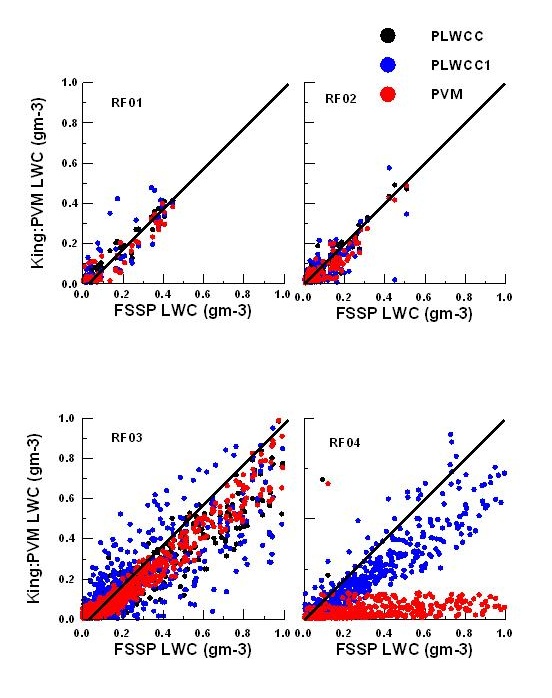
Project #1999-102 INDOEX
NSF/NCAR EC-130Q Hercules (N130AR)
Data Quality Report
Cloud Microphysical Measurements
During the 18 flights that were flown for INDOEX with the EC-130Q, all the cloud microphysical instrumentation was operational with the exception of flights RF04 and RF05 when the PVM was not turned on due to operator error. One of the hot-wire probes (PLWCC) was also not operating on flight RF04, for reasons unknown. Otherwise, all of the instruments were functioning, and comparisons of the liquid water contents (LWC) from the two hot wire probes (PLWCC and PLWCC1) and the PVM-100 (XGLWC) with the LWC derived from the FSSP-100 (PLWCF) provide a qualitative measure of the integrity of the data sets from these instruments. Some instrument-by-instrument discussions follow this overview and describe some of the expected uncertainties associated with measurements from these sensors. The figures at the end of this document show the scatter plots of PLWCC, PLWCC1 and XGLWC vs. PLWCF from all 18 flights, every cloud pass.
Additional information about the cloud-by-cloud statistics can be found at the RAF ftp site, pub/darrel/indoex" in files named "102rfXXCldStats.dat", where XX represents a flight number 01 through 18. The format of these files is in the form:
Flight Date = 21699 Research Flight # 1
Cloud Pass # 1 From 12:46:38 To 12:46:41
Latitude = 8.8143 Longitude = 70.7350
Altitude = 768.m, Cloud Width = 328.m
Temperature (C) Avg. = 20.922 Min. = 20.843 Max. = 21.060
Pressure (mb) Avg. = 928.227 Min. = 928.146 Max. = 928.311
Wind Speed (m/s) Avg. = 4.292 Min. = 3.861 Max. = 4.564
Wind Direction(deg) Avg. = 10.393 Min. = 8.374 Max. = 12.798
Vertical Wind (m/s) Avg. = 0.438 Min. = 0.209 Max. = 0.855
FSSP Conc. (cm-3) Avg. = 195.610 Min. = 54.165 Max. = 414.963
260X Conc. (/l) Avg. = 0.000 Min. = 0.000 Max. = 0.000
Med.Vol.Diam (um) Avg. = 13.187 Min. = 12.829 Max. = 13.856
FSSP LWC (g m-3) Avg. = 0.114 Min. = 0.002 Max. = 0.246
King LWC#1 (g m-3) Avg. = 0.090 Min. = 0.021 Max. = 0.146
King LWC#2 (g m-3) Avg. = 0.064 Min. = 0.036 Max. = 0.109
Gerber LWC (g m-3) Avg. = 0.056 Min. = -0.022 Max. = 0.158
FSSP-100 - The FSSPs normally have housekeeping modules in them to record the auxiliary variables, "Total Strobes" and "Total Resets." The variables are necessary for estimating the effective beam width of the FSSPs and calculating the amount of electronic deadtime. Both of these parameters are needed for calculating sample volume, used in the calculation of concentration and liquid water content. The housekeeping module was non-functional and was not repaired or replaced in the field. Hence, the calculation of sample volume has had to use some assumptions about the effective beam diameter and deadtime. These assumptions have increased the uncertainty in both concentration and liquid water content. The usual uncertainty estimates of these two variables are 15% and 35%, respectively. The approximations that had to be used for the INDOEX data increased these to approximately 20% and 40%.
Two FSSPs were operated during INDOEX. The measurements from the Left Pod FSSP (_LPI) are used in the processed data for research flights 1 through 3, while the Right Pod FSSP (_RPC) was used for flights 4 through 18. This decision was made based on an assessment of the data quality for all the flights. The Right Pod FSSP appears to be the more accurate instrument, but it was out of operation for the first three flights, so the Left Pod measurements had to be used for them.
PVM-100 - The comparisons of LWC between the PVM and FSSP are in very good agreement in most cases. The exceptions were on days like flights 7, 8 and 11, when median volume diameters were larger than 20 um, and significant portions of the LWC were in larger droplets where there has been past evidence that both the PVMs and hot-wire tend to underestimate the water content. The other problem the PVM-100 seems to have is a certain sensitivity to aerosol loading that causes shifts in its zero baseline.
Hot-Wires - The hot-wire probes appeared to function very well throughout the project and compare very well with one another, the PVM and FSSP. The exception is, as with the PVM, the hot-wire does not completely vaporize droplets larger than about 40 um, so it begins to underestimate LWC at those sizes.
260-X - The 260-X had its HeNe gas laser replaced with a higher-powered diode laser before INDOEX and, as a result, had a significantly enhanced immunity to vibration and noise. The data look excellent from this instrument. As shown in Fig. 6, the 260-X, with a lower size threshold of approximately 30-40 um, only responds when the FSSP-100 median volume diameter is larger than about 20 um. This provides a very good sanity check for the 260-X. Comparison of size thresholds also show excellent agreement in the overlapping size ranges.

Figure 1
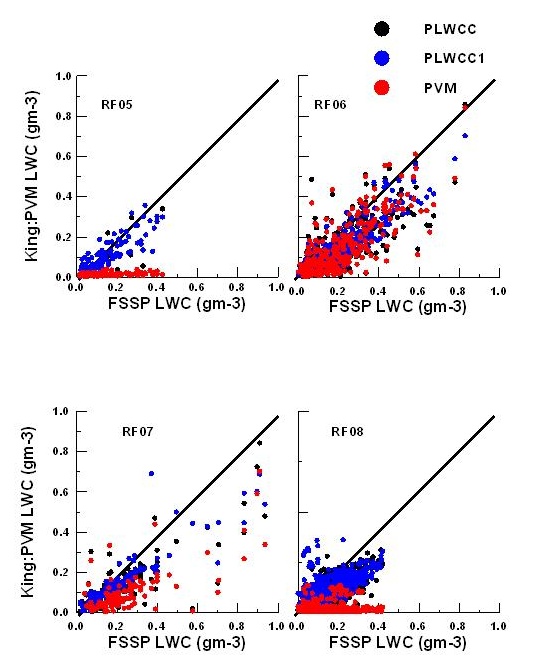
Figure 2
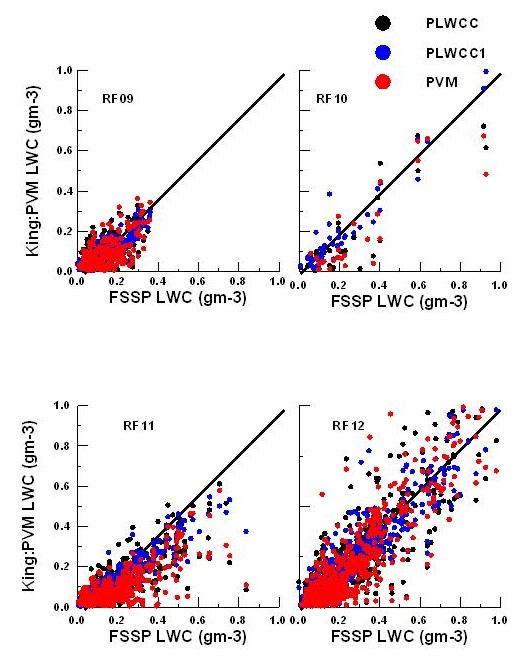
Figure 3
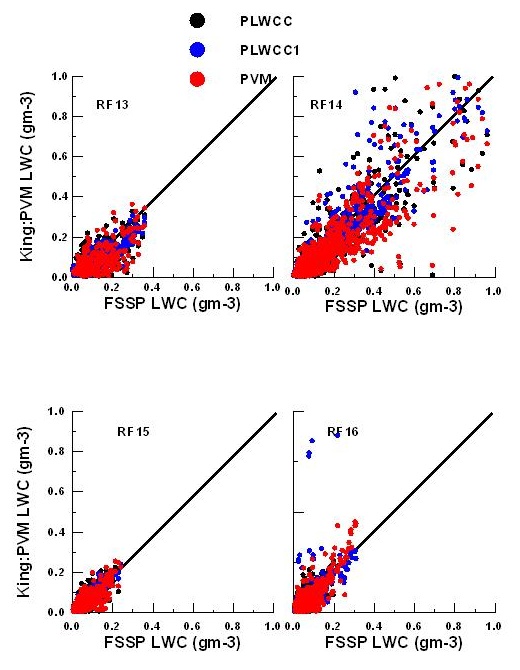
Figure 4
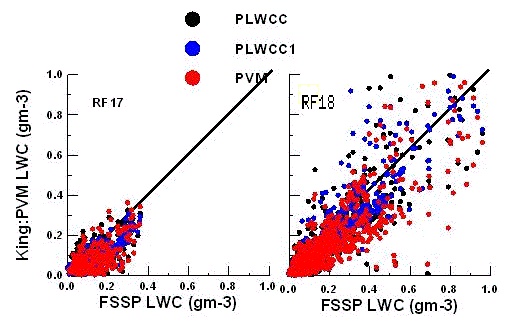
Figure 5
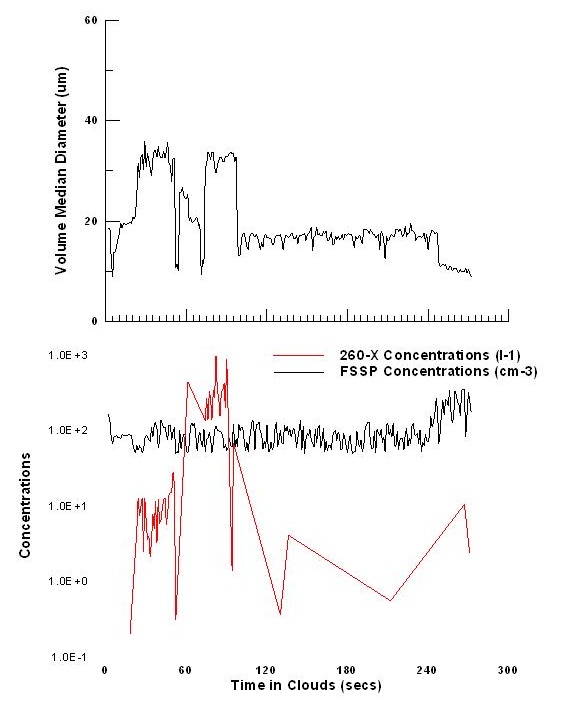
Figure 6